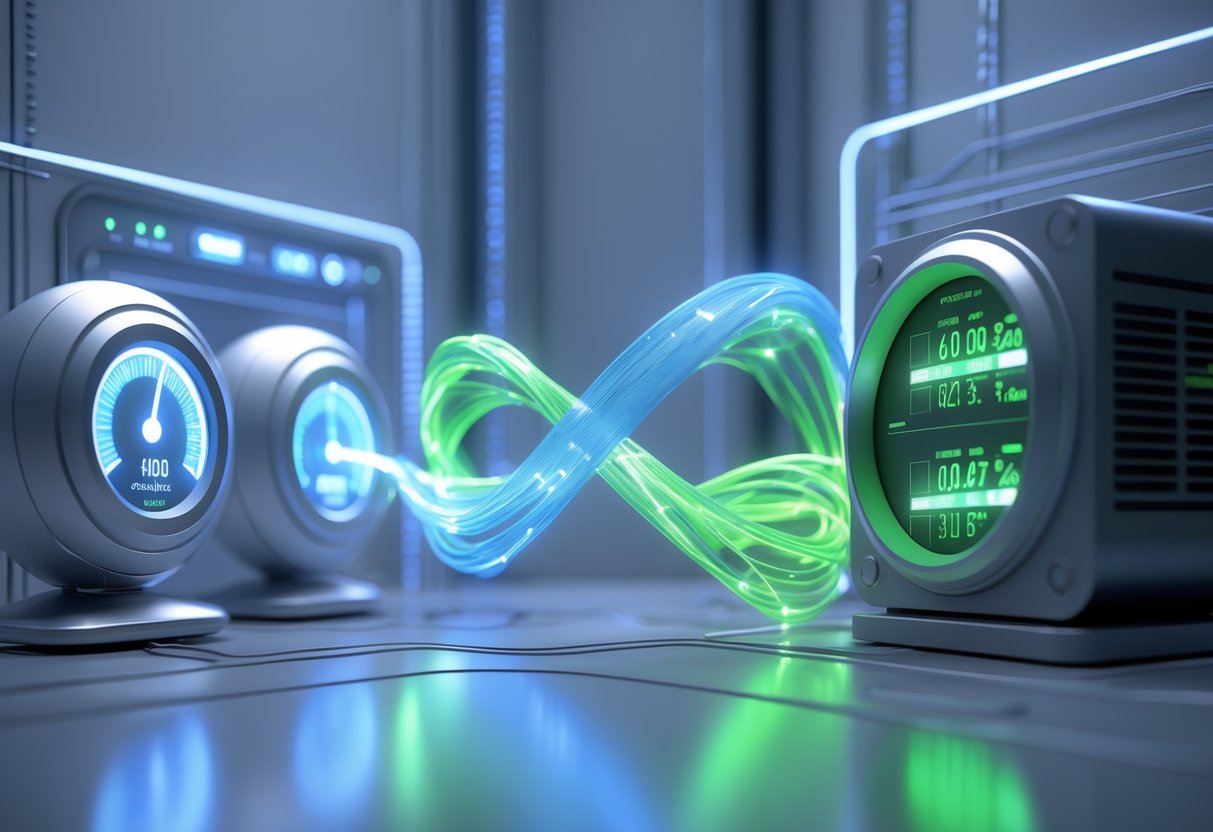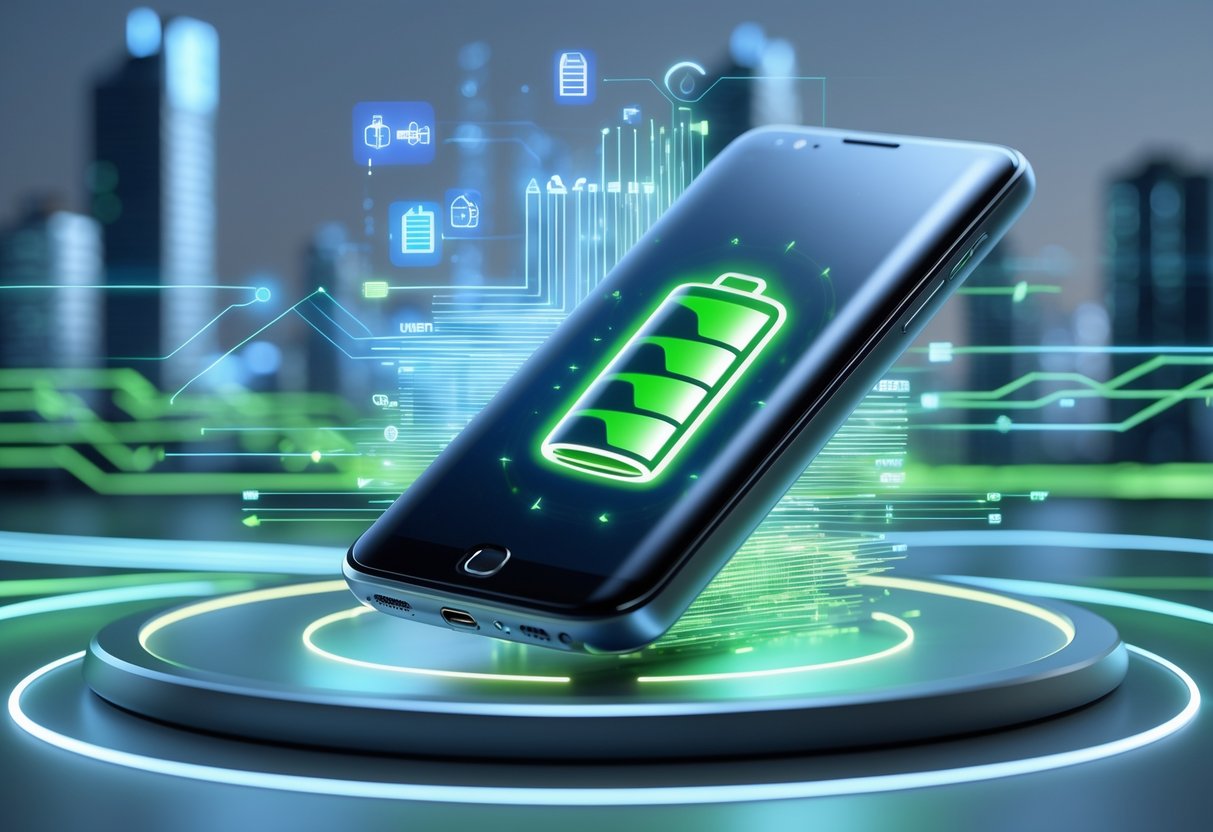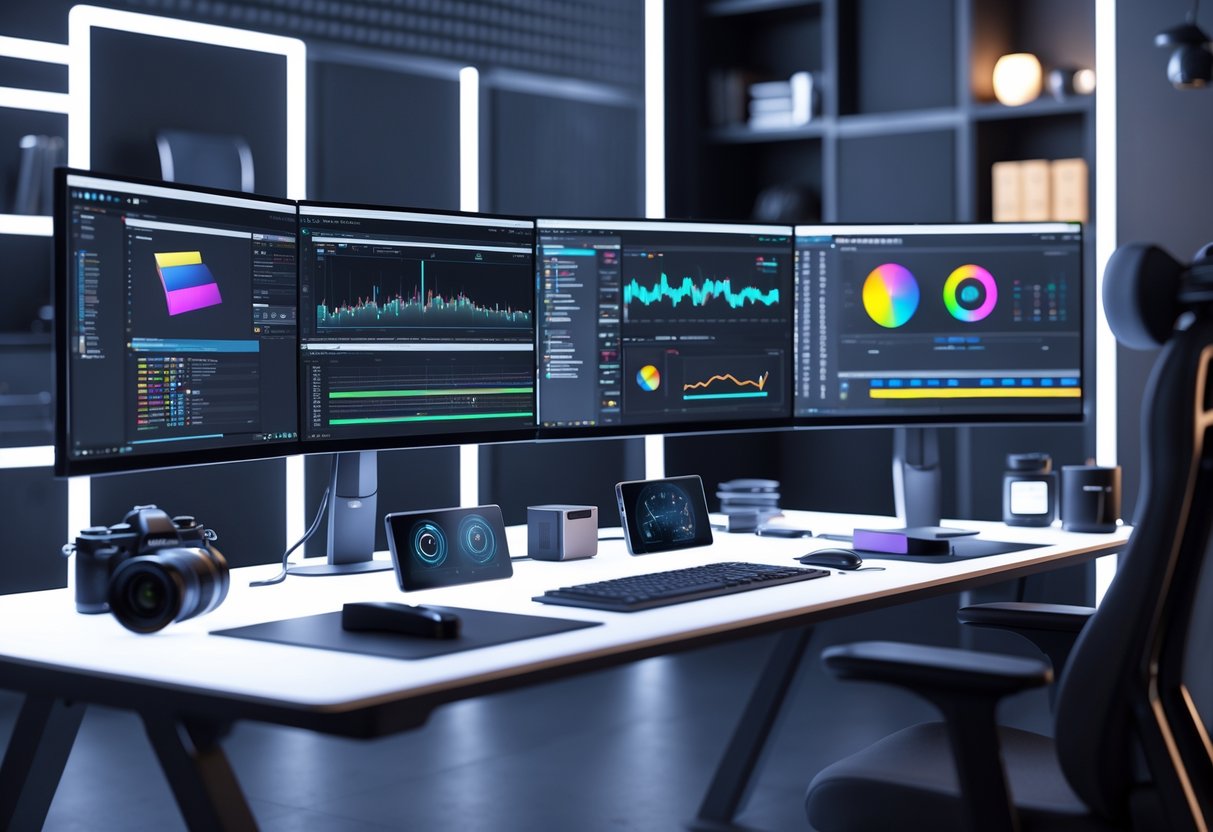Ultimate Usage Efficiency: Maximising Windows PC Performance
Updated On: November 13, 2025 by Aaron Connolly
Understanding Ultimate Usage Efficiency

Ultimate usage efficiency is all about squeezing the most meaningful work out of every bit of power your system uses. Think of it like building on Power Usage Effectiveness (PUE), but digging deeper—it’s not just about the building, it’s about real productivity per watt.
Definition and Key Concepts
Ultimate usage efficiency looks at how well we turn electrical power into actual computing results. Unlike old-school PUE, which mostly checks infrastructure overhead, this one zooms out to the whole power-to-productivity chain.
You’ve got three big pieces in the formula: total energy used, useful work done, and waste cut out. Useful work covers stuff like processing, storing data, and network tasks that actually help end users.
Infrastructure efficiency means things like cooling, power delivery, and keeping the place running. Computational efficiency is more about how your processors, memory, and storage eat up the power they’re given.
Power management really changes the game. Modern systems can slow down parts, move jobs to more efficient hardware, or just shut down what’s not needed. These tricks make a real dent in your efficiency score.
You can measure this with watts per transaction, energy per calculation, or power per active user. These numbers show you the real deal: how much work you’re getting for your power, not just how efficient your building is.
Why Ultimate Efficiency Matters
Energy bills eat up 20-30% of what it costs to run a data centre. If you boost ultimate efficiency, you can shrink those bills and maybe even do more with the same hardware.
Organisations care more about the environment these days, especially with carbon targets getting stricter. Every bit of efficiency means less pollution and less wasted resources.
When your systems run at peak efficiency, you get noticeable performance perks. Apps feel snappier, and you can handle heavier loads without buying more gear.
Power management systems are getting smarter, too. They can guess when loads will spike, move resources around, and spread out energy use across the whole place.
Rules and regulations push a lot of companies to get more efficient. In the EU and UK, for example, big operators have to measure and improve efficiency to meet climate targets.
If you can run things more efficiently, you get a leg up on the competition. Lower costs mean you can offer better prices or put that money into something new.
Common Misconceptions
Some folks think hitting a PUE of 1.0 is the same as ultimate efficiency. Not really—perfect infrastructure doesn’t mean your actual computing work is maxed out.
There’s this myth that better performance always means more power. But newer processors and storage devices often give you more bang per watt than so-called “efficient” old hardware.
People often worry that making things efficient will cost a fortune. Actually, just tweaking software, scheduling jobs smarter, and using basic power management can give you a solid boost for cheap.
Another misunderstanding: efficiency means slower performance. In reality, modern power management can ramp things up when needed and save energy when you’re not pushing the system.
You’ll hear that only big data centres should care about efficiency. But honestly, small businesses and edge setups can get even more out of it since they’re usually tighter on budget.
A lot of organisations get scared off because they think measuring efficiency is too complicated. Good news: simple monitoring tools and basic math will already tell you a lot, no PhD required.
How Power Plans Influence Usage Efficiency
Windows power plans let you control how your CPU acts while gaming, which affects both speed and how much energy you burn. The main thing that sets these plans apart is how they handle CPU speeds and what happens when your machine isn’t busy.
Overview of Windows Power Plans
Windows comes with built-in power plans that decide how your computer uses energy. You’ll usually see three choices: Balanced, High Performance, and Ultimate Performance.
Balanced mode lets your CPU speed up or slow down depending on what you’re doing. If you’re just browsing, it chills to save power. When you game, it wakes up and gets to work.
High Performance mode keeps your CPU running at top speed all the time. It won’t slow down, even if you’re just staring at your desktop.
Ultimate Performance mode strips away every last bit of power-saving, even more than High Performance. You get everything the hardware can give, but your energy use goes way up.
Each plan changes how your system feels. For gaming laptops, picking the right one matters a lot since battery life is a real concern compared to desktops.
Differences Between Balanced, High Performance, and Ultimate Performance
The real difference between these plans? It’s all about idle power and how the CPU acts.
| Power Plan | CPU Behaviour | Energy Use | Best For |
|---|---|---|---|
| Balanced | Scales with demand | Low when idle | Daily gaming |
| High Performance | Always at max speed | High constantly | Competitive gaming |
| Ultimate Performance | Maximum with all limits removed | Highest | Professional esports |
Balanced mode is usually good enough for most gamers. The CPU speeds up when the action gets intense and chills out during menus or loading screens.
High Performance mode cuts out the tiny delays that happen when the CPU wakes up from idle. That matters if you’re playing at a high level and every millisecond counts.
Ultimate Performance mode throws out the last of Windows’ power-saving tricks. You might only see a tiny boost over High Performance, but for pros, every bit helps.
Energy use jumps a lot between these modes. High Performance can chew up 20-30% more power than Balanced, even if you’re not doing anything.
Ultimate Performance Power Plan Explained
Windows gives you a few power plans, but Ultimate Performance is the most aggressive. This hidden option ditches all power-saving features and wipes out those tiny delays when hardware asks for more power.
What Is Ultimate Performance Mode?
Ultimate Performance mode is a special plan for high-end workstations and gaming rigs. Microsoft dropped it in Windows 10 version 1803, and it’s still around in Windows 11.
Unlike the other plans, Ultimate Performance just lets your hardware take as much power as it wants, instantly.
This plan targets micro-latencies—those little pauses that happen when parts of your system ask for more juice. They’re tiny, but if you’re gaming or creating content, they can add up.
Key differences from High Performance mode:
- No power throttling at all
- CPU parking is off
- No power state transitions
- Memory and storage run at full speed
You won’t see Ultimate Performance in the menu by default. You have to turn it on yourself with Command Prompt or PowerShell.
This plan is really meant for desktops with a steady power supply. If you use it on a laptop, expect your battery to vanish fast.
Key Features and Technical Highlights
Ultimate Performance flips a bunch of system settings to max out speed. Here’s what really changes:
CPU Management Changes:
- Minimum processor state: 100%
- Maximum processor state: 100%
- CPU parking: off
- Core parking threshold: 100%
Memory and Storage Tweaks:
- Hard disk never times out
- USB selective suspend: off
- PCI Express link state: off
- SATA power: max performance
Your graphics card also stays fired up longer and doesn’t switch power states as much.
Heads up: Ultimate Performance can bump your power use by 10-20% over High Performance. You’ll notice it when your power bill shows up.
Gamers might see a 2-5% bump in CPU-heavy games. If you’re streaming or recording at the same time, it can matter more.
Workstations get the biggest boost during video editing, 3D modeling, or crunching big data. Consistent power means you don’t get those annoying slowdowns in the middle of a long job.
Enabling Ultimate Performance on Windows 11
Windows 11 hides the Ultimate Performance plan by default, but you can unlock it and blow past High Performance by removing all power management delays. There are three main ways to do it: the Settings app, Command Prompt, or PowerShell.
Using Power Options in Settings
First, you’ll need to turn on the Ultimate Performance plan using PowerShell so it shows up in the Settings app.
Open PowerShell as an admin. Hit Windows + X and pick “Windows Terminal (Admin)” or “PowerShell (Admin)”.
Type this in and hit Enter:
powercfg -duplicatescheme e9a42b02-d5df-448d-aa00-03f14749eb61Once that’s done, go to Settings > System > Power & battery > Power mode. You should see Ultimate Performance in the dropdown.
Pick “Best performance” and you’re set.
Just a heads up: This only works when your PC is plugged in. If you’re on battery, the option disappears.
Activating via Command Prompt
You can do the same thing with Command Prompt.
Search for “cmd” in the Start menu, right-click it, and choose “Run as administrator”.
Enter the same command:
powercfg -duplicatescheme e9a42b02-d5df-448d-aa00-03f14749eb61After you hit Enter, Windows 11 adds the Ultimate Performance plan to your system.
Go to Control Panel > Hardware and Sound > Power Options. You’ll find Ultimate Performance under “Hide additional plans”.
Expand that section and click Ultimate Performance. Your PC will switch to it right away.
Enabling with PowerShell
PowerShell is the most reliable way to get Ultimate Performance running, no matter your Windows 11 version.
Open PowerShell as an admin from the Start menu or by pressing Windows + X.
The command powercfg -duplicatescheme copies Microsoft’s hidden Ultimate Performance template to your system. That long code (e9a42b02-d5df-448d-aa00-03f14749eb61) is the plan’s ID.
To check if it worked, type:
powercfg -listYou’ll see all available power plans, including Ultimate Performance.
To set it as your active plan, either use the Control Panel or run:
powercfg -setactive e9a42b02-d5df-448d-aa00-03f14749eb61Pro tip: Save that PowerShell command somewhere if you reinstall Windows 11 or set up a new gaming PC.
Enabling Ultimate Performance on Windows 10
Ultimate Performance mode strips away power-saving features and micro-latency to make your system feel as snappy as possible. It’s a hidden plan, and you’ll need to jump through a few hoops to turn it on—plus, it really only shines on high-end systems with solid cooling.
Requirements and Limitations
Not every Windows 10 machine shows Ultimate Performance by default. Laptops usually hide this option since it eats through battery life fast.
Workstations and beefy gaming PCs get the most out of it. You’ll want good cooling since your hardware will run full-tilt all the time.
Here’s what you should know:
- Power use goes way up
- Your system will run hotter
- Gaming gains are usually tiny
- It’s best for content creators or pros running heavy workloads
If you’re on a laptop, only use Ultimate Performance when plugged in. Desktop users should double-check their power supply and cooling before flipping the switch.
You’ll see the biggest difference in video editing and 3D design apps. Most modern games already use hardware pretty efficiently, so don’t expect miracles there.
Step-By-Step Guide
Start by checking if Ultimate Performance shows up in your current power options. Hit Windows + I and go to System > Power & Sleep.
Click “Additional Power Settings” under Related Settings. Find “Show Additional Plans” and see if Ultimate Performance is in the list.
If you don’t see Ultimate Performance, turn it on using Command Prompt:
- Right-click the Start menu and pick “Windows PowerShell (Admin)”
- Type:
powercfg -duplicatescheme e9a42b02-d5df-448d-aa00-03f14749eb61 - Hit Enter
Go back to Power Options and refresh the window. Now, Ultimate Performance should appear under additional plans.
To activate the plan:
- Click the Ultimate Performance radio button
- Close Power Options
Your system jumps straight into maximum performance mode. Keep an eye on temps during heavy use—make sure your cooling can keep up with the extra heat.
Advanced Power Settings for Maximum Efficiency

Windows 11 gives you a lot of control over how your system uses power. With advanced power settings, you can juggle performance and battery life through custom plans and processor tweaks.
Accessing Advanced Power Settings
Getting to advanced power settings in Windows 11 isn’t hard, but it’s not exactly obvious either. The quickest way? Open the Control Panel’s power options.
Press Windows + X and pick “Run”. Type powercfg.cpl and press Enter. That brings up the classic Power Options window.
You can also get there through Settings under System > Power & battery > Additional power settings. Both routes land you in the same spot.
Once you’re in, click “Change plan settings” next to your current plan. Then hit “Change advanced power settings” to see the full list.
You’ll see expandable categories in the advanced settings window. Each one lets you tweak power management for different hardware.
Customising Power Plans
Windows 11 ships with three default power plans, but making your own gives you more flexibility. Each plan saves settings for different scenarios.
The Balanced plan adjusts performance on the fly. Power saver stretches battery life, sacrificing speed. High performance cranks up system speed, using more energy.
To make your own plan, click “Create a power plan” on the left. Pick a base plan, then give your new setup a name.
Custom plans shine when you tailor them for specific uses. Set up different ones for gaming, work, or travel.
| Plan Type | Best For | Battery Impact |
|---|---|---|
| Power Saver | Light tasks, travel | Maximum life |
| Balanced | Daily computing | Moderate usage |
| High Performance | Gaming, intensive work | Highest consumption |
Switching between plans is quick—just use the battery icon in the system tray. That way, you can adapt as your power needs change.
Processor Power Management
Processor power management really shapes how your CPU uses energy. These settings have a huge effect on both speed and battery life.
Minimum processor state sets how slow your CPU can go when it’s idle. Lower numbers save battery, but you might notice a tiny lag when you get back to work.
Maximum processor state puts a cap on peak CPU speed. Setting this under 100% cuts down on heat and power draw during heavy tasks.
System cooling policy decides how Windows tackles heat. “Active” spins up fans first, while “Passive” slows down the CPU to cool things off.
For laptops, try minimum state at 5% on battery, 10% plugged in. Most people can set maximum state to 80% on battery.
Desktops can run higher minimums since power isn’t a big concern. Gaming PCs usually want a 100% max processor state.
Changes take effect right away. Watch your temps and performance to find what works for you.
Performance Monitoring and Tools

Keeping tabs on your system’s performance helps you spot bottlenecks and squeeze out more gaming power. Task Manager gives you the basics, but tools like MSI Afterburner and HWMonitor dive deeper into hardware stats.
Task Manager Insights
Task Manager is a lifesaver when you want a fast look at resource usage. Just press Ctrl + Shift + Esc to pop it open.
The Processes tab lists CPU and memory use for every app. Sort by CPU to catch any process hogging resources. If something’s eating more than 20% CPU when you’re not gaming, that’s a red flag.
Check the Performance tab for real-time graphs. Key things to watch:
- CPU usage should stay under 80% for normal stuff
- Memory usage over 80% means you might need more RAM
- GPU usage tells you if your graphics card is working overtime
You can kill unnecessary processes by right-clicking and choosing “End task”. Just don’t nuke anything Windows needs to run.
Quick tip: Shut down Chrome tabs and background apps before gaming. You can free up 2-4GB of RAM instantly.
Using MSI Afterburner and HWMonitor
MSI Afterburner is great for tracking GPU performance and even overclocking. Grab it for free from MSI’s site—it works on any graphics card, not just MSI.
You’ll see GPU temps, usage, and clock speeds right on the main screen. Turn on the on-screen display to monitor these while gaming. If your GPU hits 80°C or higher, you might need better cooling.
HWMonitor tracks all sorts of sensors—CPU temps, fan speeds, voltages. It’s awesome for spotting overheating parts.
Temperature limits to keep in mind:
- CPU: Stay under 80°C
- GPU: Don’t go above 85°C
- SSD: Keep below 70°C
Both tools log data over time. After a gaming session, check the highest temps. If they’re always high, look at your case airflow or maybe clean your components.
High temps can cause throttling and shorten hardware life. It’s just not worth the risk.
Balancing Power Consumption and Efficiency

Power plans affect how much energy your system uses and how much heat it makes. Both impact your gaming and your electric bill.
Impact on Energy Usage
Ultimate Performance mode removes all power-saving limits from your CPU and hardware. Your system runs flat-out, even during simple tasks.
Energy use jumps by 15-30% compared to balanced mode. You’ll probably notice this on your power bill if you game a lot.
Desktops handle this extra draw better than laptops. Gaming desktops already use 300-500 watts during heavy loads, so the difference isn’t huge.
Laptops, though, really feel the hit. Battery life drops fast in Ultimate Performance mode. Expect 2-4 hours less on a charge.
Here’s a quick look at how power modes stack up:
| Power Mode | Desktop Energy Use | Laptop Battery Life |
|---|---|---|
| Balanced | Moderate (adjusts automatically) | 6-8 hours typical use |
| High Performance | 10-20% higher | 4-6 hours typical use |
| Ultimate Performance | 15-30% higher | 2-4 hours typical use |
Switch power modes to fit what you’re doing. Use balanced for browsing, Ultimate Performance just for gaming or streaming.
Heat Generation Considerations
More power means more heat—pretty simple. Your cooling system has to work harder to keep things safe.
CPU temps can rise by 5-15°C in Ultimate Performance mode. That puts extra stress on your fans and cooling gear.
Gaming laptops have a tough time here. Bad airflow and max power draw can cause thermal throttling. Performance drops when things get too hot.
Desktops usually handle extra heat better. Most gaming PCs have cooling for Ultimate Performance mode. Watch your temps during your first few sessions.
Signs of overheating: • Fans get loud • Games start stuttering • System shuts down unexpectedly • Frame rates drop after 30+ minutes
Room temperature matters too. Hot summer days make overheating more likely, especially if your setup doesn’t get good airflow.
Check your component temps with tools like HWiNFO64. Try to keep CPU under 80°C and GPU under 85°C.
Effect on Battery Life and Portable Devices

Ultimate Performance impacts how long your gaming laptop lasts and how well portable devices handle demanding games. Power use becomes a big deal when you’re playing tournaments or streaming for hours without a charger.
Ultimate Efficiency on Laptops
Gaming laptops have their own set of headaches at high settings. With some tweaks, you can stretch battery life from 2-3 hours up to 4-5 hours while gaming.
CPU and GPU Management Modern CPUs and GPUs have built-in power-saving tricks. During chill moments in games like CS2 or Valorant, your laptop automatically dials back power use.
Display Optimisation The screen eats up 30-40% of your battery. Drop brightness from 100% to 70% and you might get another hour of play. Honestly, a lot of pro players like their screens a bit dimmer for better contrast anyway.
Background Process Control Background apps are battery killers. Shut down Discord overlay, RGB tools, and streaming apps if you’re on battery.
Thermal Throttling Impact When your laptop overheats, it slows down to cool off, but that can actually waste more power trying to keep frame rates up. Good cooling keeps both battery life and performance steady.
Battery Life Implications
Long gaming sessions really show how power use affects your performance. After a year or so of heavy use, battery wear becomes obvious.
Performance Scaling Most gaming laptops slow down CPU and GPU when unplugged. That can drop you from 144fps to 90fps—pretty noticeable in competitive play. It’s usually better to tweak in-game settings yourself instead of letting the laptop auto-scale.
Charging Behaviour Leaving your laptop plugged in all the time isn’t great for battery health. Some pros use 80% charge limits to help their batteries last longer, while still getting max performance during matches.
Power Profile Settings Windows power profiles really change battery life:
- Balanced mode: 3-4 hours typical gaming
- Power saver: 5-6 hours, but you’ll sacrifice performance
- High performance: 1-2 hours at full tilt
Tournament Considerations Big tournaments usually have power, but smaller events might not. Practising on battery helps you get used to possible frame drops during real matches.
Content Creators and High-Intensity Workloads

Content creators push their rigs to the edge with 4K video edits, live streams, and 3D rendering. The right performance tweaks and hardware choices can seriously cut render times and smooth out creative workflows.
Benefits for Content Creators
Content creators see huge productivity boosts when their systems handle high-intensity workloads efficiently. Video rendering times drop a ton with CPUs like the AMD Ryzen 9 7950X3D, which rocks 16 cores and 32 threads for multitasking.
We’ve seen creators cut 4K export times from hours to just minutes. The Intel Core i9-14900K’s 24-core setup powers through streaming and recording at the same time without dropping frames.
Tweaking performance settings matters a lot here. Many creators find that adjusting power profiles and memory speeds unlocks real gains. The AMD Ryzen 7 9800X3D, for example, brings 16% more instructions per clock—meaning faster content crunching.
The difference shows up in everyday work. Creators get smoother timeline scrubbing in Premiere Pro and faster previews in After Effects. Multi-core CPUs handle background rendering while you keep editing, which is just so much better for getting things done.
Ideal Scenarios for Ultimate Usage Efficiency
Live streaming with simultaneous recording really shines on high-performance systems. Streamers running processors like the AMD Ryzen 9 9950X3D often see up to a 34% frame rate boost while keeping their broadcasts looking sharp.
We like these scenarios best for squeezing out every bit of efficiency:
- 4K video editing with lots of camera angles
- 3D rendering and animation work
- Music production with tons of audio tracks
- Game development for compiling and testing
Performance settings make a huge difference here. Most creators enable XMP profiles to speed up their memory and tweak CPU boost settings. The Intel Core Ultra 9 285K, for example, can hit 5.7 GHz, which is fantastic for single-threaded stuff like audio processing.
Cooling isn’t optional at this level. If you’re using something like a Threadripper, you pretty much need liquid cooling to keep things stable during long rendering sessions.
A lot of creators realize that proper system configuration beats just throwing money at new gear. Dialing in the right settings can bump up performance by 20-30%—no extra cash needed.
Troubleshooting and Best Practices

Getting the most out of your gaming setup means knowing how to fix problems as they come up. Let’s look at some common headaches when you push for max performance, plus a few ways to keep things humming along.
Issues When Enabling Ultimate Performance
Power Settings Conflicts usually cause the most trouble. Systems crash or freeze when you switch to ultimate performance, mostly because the hardware can’t keep up with the sudden power draw.
Start by checking your advanced power settings. Go to Control Panel > Power Options > Change plan settings > Change advanced power settings. Double-check for any custom tweaks that might clash with ultimate performance mode.
Overheating creeps in fast when you max out power. Your CPU and GPU work overtime and pump out a lot of heat. Weak cooling leads to thermal throttling, which actually slows things down.
Keep an eye on temps using MSI Afterburner or HWiNFO64. Try to keep CPU temps under 80°C and GPU temps under 83°C when gaming.
Power supply issues tend to show up as random shutdowns or blue screens. Ultimate performance can push your PSU too hard. A 650W supply might not cut it for a top-tier graphics card running at full tilt.
Driver conflicts can cause stutters or crashes when you switch power modes. Old or incompatible drivers just don’t play nice with aggressive power settings.
Always update your graphics drivers before flipping on ultimate performance. If you still hit snags, use DDU (Display Driver Uninstaller) to clear out old drivers.
Tips for Maintaining Peak Efficiency
Set up proper monitoring before you start pushing your system. Install tools for temperature and performance monitoring so you can catch issues early. HWiNFO64, MSI Afterburner, and Windows Performance Toolkit all help.
Create custom fan curves in your BIOS or with something like Fan Control. Set cooling profiles that ramp up before things get too hot.
Regular maintenance keeps your rig in shape. Clean dust from your case every three months. If you run ultimate performance often, reapply thermal paste on your CPU every year.
Update your BIOS and drivers at least once a month. Manufacturers roll out optimizations pretty regularly for high-performance modes.
Use correlation IDs when you log system events. This makes it easier to track problems across different programs and speeds up troubleshooting.
Test incrementally instead of jumping to max settings right away. Slowly raise power limits and watch for stability. This way, you’ll know your actual limits.
Keep notes on what settings work best for each game. Some games love more CPU power, others respond better to GPU tweaks.
Have rollback plans ready to go. Know how to quickly turn off ultimate performance if things go sideways during an important stream or gaming session.
Frequently Asked Questions

The Ultimate Performance power plan brings up a lot of questions. People want to know how to turn it on in Windows, what risks it carries for different hardware, and if it really helps gaming performance. Here’s what stands out about activation, possible drawbacks, and real-world performance differences.
What steps do I need to take to enable the Ultimate Performance power plan on Windows 11?
You can turn on Ultimate Performance with Command Prompt or PowerShell in Windows 11. Right-click the Start button and pick “Windows Terminal (Admin),” or search for “cmd” and run it as administrator.
Type this command: powercfg -duplicatescheme e9a42b02-d5df-448d-aa00-03f14749eb61. Hit Enter.
Now, open Settings and go to System > Power & battery. Click “Power mode” and you should see Ultimate Performance as an option along with Balanced and High Performance.
You can also find it in Control Panel under Hardware and Sound > Power Options. Ultimate Performance should show up in your power schemes list.
Are there any risks associated with enabling Ultimate Performance on a less powerful PC?
Yeah, there are a few. Your CPU and other parts will run flat out more often, so they’ll get hotter. If your cooling isn’t up to the task, things can get dicey.
Older or cheaper laptops have the biggest problems. They usually don’t have great cooling and might throttle performance, making things worse than just using High Performance mode.
Battery life takes a big hit on laptops. Ultimate Performance keeps everything awake, so your battery drains much faster.
You’ll probably see higher electricity bills, too. Parts that would usually chill out during light tasks keep chugging along at higher power.
How does the Ultimate Performance power plan compare to the High Performance option in terms of gaming performance?
Honestly, the gap between Ultimate and High Performance for gaming is pretty small. Most games only gain 1-3% in frame rates, and you might not even notice during play.
Ultimate Performance does get rid of micro-latencies that High Performance leaves in. This can smooth out frame times and trim input lag, which is a nice perk for competitive esports games.
High Performance already turns off most power-saving features that matter for gaming. Ultimate Performance just takes it a step further, but you hit diminishing returns fast.
Your graphics card matters way more for gaming performance than your power plan. Upgrading your GPU will make a far bigger difference than switching power modes.
Can the Ultimate Performance power plan truly boost frames per second in games?
Ultimate Performance can give a small FPS bump—maybe 2-5 frames per second in CPU-heavy games. You’ll notice the boost most if your CPU is the bottleneck, not your GPU.
Games like CS2, Valorant, and League of Legends might get slightly better 1% and 0.1% low frame rates. That means fewer hitches during busy moments.
How much you gain really depends on your hardware. High-end CPUs with good cooling see the most benefit, while older chips won’t change much.
Don’t expect miracles. If you’re getting 60 FPS on High Performance, Ultimate might nudge you up to 62-65 FPS—not 80 or 90.
What are the key differences between Ultimate Performance and High Performance settings on Windows 10?
Ultimate Performance strips out all power-saving restrictions, while High Performance still leaves a few in place. High Performance lets some minor power management features stay active, but Ultimate turns them all off.
CPU parking works differently, too. High Performance might still park some CPU cores during light work, but Ultimate keeps every core awake and ready.
Memory and storage act differently as well. Ultimate Performance stops RAM from dropping into low power states and keeps NVMe SSDs running at full speed.
Power use jumps more with Ultimate than with High Performance. You could see 10-20% higher electricity use, even if you’re just browsing the web.
What have users on Reddit noticed about the High Performance versus Ultimate Performance power plans?
Reddit users say the differences feel pretty minimal for everyday stuff. Most folks don’t notice much change when they’re just browsing, watching videos, or opening up some spreadsheets.
Gamers on Reddit sometimes claim Ultimate Performance gives them a bit smoother gameplay, especially in CPU-heavy games. Still, unless you’re checking your frame rates with software, it’s honestly hard to tell.
Laptop users, though, keep warning about more heat and louder fans when they switch to Ultimate Performance. Some threads even talk about laptops hitting thermal limits, which actually slows things down compared to just using High Performance.
Content creators and streamers seem to get the most out of it. People who render videos or juggle a bunch of demanding apps at once notice their workflow gets a little faster, and processing times drop.

